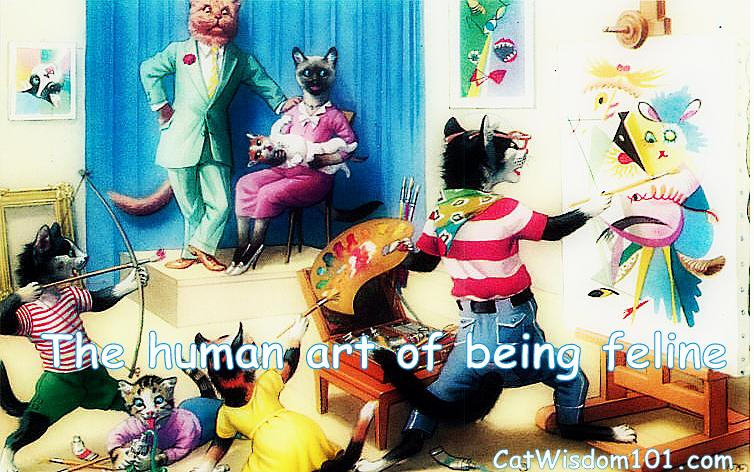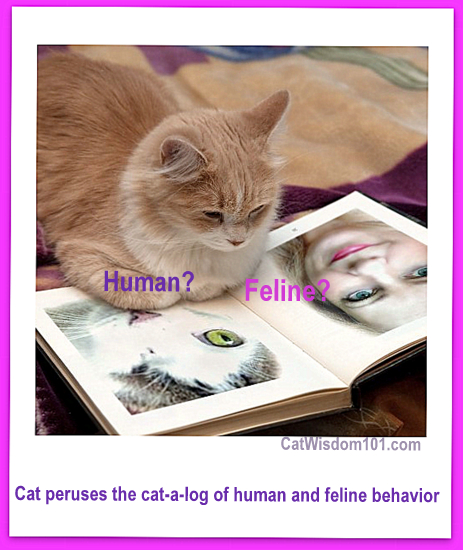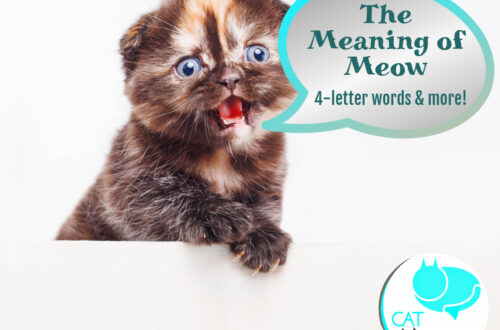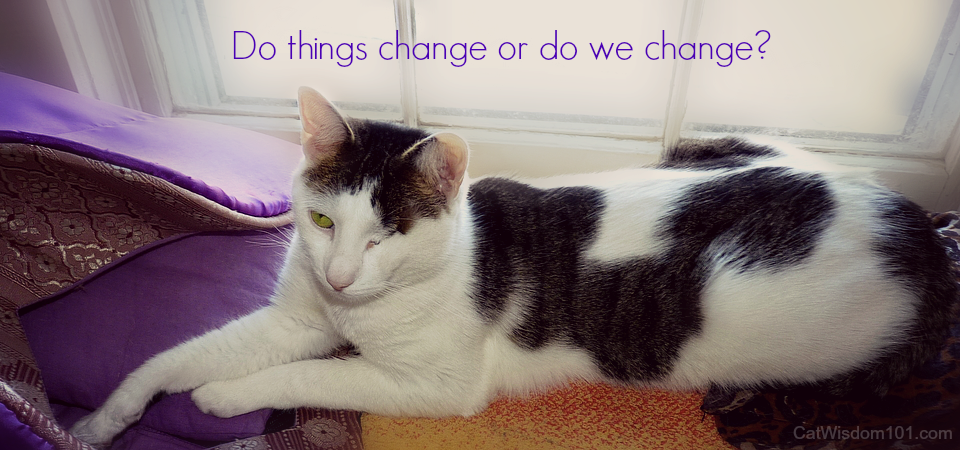
Our guest blogger for Vet 101 Q & A is Dr. Letrisa Miller, a veterinarian with a feline exclusive practice. With cats being the subject of endless jokes, it’s easy to anthropomorphize them and be confused by their behavior.
Q: Do cats think they are people, or do they realize they are a different species than
their caretakers?
A: In most cases, cats do seem to recognize that they are not the same as their human housemates. For example, they generally don’t respond to humans in the same ways they respond to other cats. Cat to cat communication can be subtle and highly complex (I discussed this a little in an
earlier post about cat behavior).
Cats have a specific etiquette when interacting with one another, but they tolerate quite a lot of rudeness from humans. For instance, cats that don’t know one another well and belong to the same social group don’t touch each other unless they are involved in a fight. Two cats will start out by looking at and smelling each other from a distance. Human like to interact with cats by touching them first with a pet down the back or a scratch to the top of the head as a greeting, then start to get to know the cat. If a cat did this to a another cat with which it was unfamiliar, it would get a violent response!
As a cat veterinarian, I have to apologize to cats constantly for my rudeness, but that’s probably a different story . . .
Cats definitely seem to know that different behavior standards apply for cats and humans, and this suggests to me that they perceive humans as a different species (or at least as “not-cats”).
Orphan kittens that are hand-raised without other cats do seem to have a problem making this distinction, however. And that can lead to behavioral problems. People usually do not like it when cats treat them like other cats. We humans tend not to understand many of the cues cats give, and we’re almost completely oblivious to how cats use odor and smell to communicate. So, when a cat treats us like a cat, and we don’t respond in the way a cat should, or, worse, we respond in way that an aggressive, threatening cat would, this may confuse the cat or cause it to respond inappropriately.
I often see this manifest in situations where a cat’s human companion is trying to introduce new humans into a household, whether a new spouse or partner or a new child, or even a temporary presence such as a dinner guest. The cat might perceive the new human as an invader on its territory (territory it has been careful to scent-mark, post “no trespassing” signs, as it were). When this happens, violence can ensue.
When cats think humans are cats, they tend to get frustrated with the humans and try to communicate with teeth and claws when their efforts at more subtle communication fail. This is isn’t too surprising. Many of us get annoyed or frustrated when a fellow human being ignores our verbal and body language cues. We typically respond (one hopes!) by signaling our discomfort a bit more clearly and, if that fails, by speaking politely to the offending person. But if the annoying behavior continues, we’re likely to modulate our communication, making it blunter and ruder in an effort to get through. That cats would approach annoying or frustrating behavior in a similar manner makes sense.To sum up, my opinion is that most cats do recognize they are not humans and that humans are not cats, but the exceptions are notable and can lead to serious behavioral problems.

Letrisa Miller, MS, DVM
Connecticut Feline Medicine & Surgery
Editor’s Note: We urge anyone living or interacting with cat to learn their body language and etiquette. Rule # 1: Never approach a familiar cat too quickly. Bend down to make yourself appear smaller. Remove sunglasses or large eyeglasses which may magnify your eyes and frighten some cats. Communicate your intention. A loving thought and soft-spoken greeting. Extend a finger at nose height so the cat can sniff it. Wait and see what they do. Watch their ears and tail for movement. Beware of ears flattened to the sides of their head and a sideways swishing tail. They may sniff, touch you hand, rub up against you with an upright tail. If so, consider this an invitation to possibly pet them. If they respond positively, explore further with maybe a chin rub but keep your first contact or introduction short. If all goes well, there will be a second time.
Look for other articles in our Cat Behavior 101 category in our sidebar.







23 Comments
Arnette
If you are interested in topic
Virgilio Lao Muy
Animals needs our care ! Animals are Animals,,,Humans are Humans ! Some Stupid Scientist creating their own stupid experiments !
Lourdes
I got my two cats while my husband was away for a couple of months finishing grad school and when he came back one of my cats kept walking around, at a distance of course, this new person in the house. The next morning (they were already used to sleeping with me) Karu (my tabby) sprayed my husband while he was sleeping (jajaja). I guess he was marking him his… Five years later, they are inseparable and the marking was a one time thing 😉
Ryker's Boys and Allie (@Ryker_Tyker)
VERY interesting article. Maxwell: (holds Faraday’s ears shut) My little brother here was weaned too early so Mama was worried he’d have that connection, but other than nipping he seems to be adjusting just fine (though he is very clingy to her).
Bernadette
My cats have always been willing to try out other humans to see if they are any more interesting than their human, who does nothing but sit and stare at things all day. Aside from the former ferals who usually vaproized or tried to act as if they weren’t there, all my cats greet people at the door, most of whom are also cat people.
CATachresis
Great post! Whenever I do or wear something different and is unfamiliar to Austin, he quite often will give me a wide berth until he is sure. xx
Cynthia Southern
My cats think they are more evolved than me and they even speak a different language…catonese.
Glogirly and Katie
Super interesting!!! It’s made me thing back to potential mistakes I’ve made and it all makes sense. …of course the BIGGEST was the cat ear headband I put on a few Halloween’s ago. Thinking it would be fun to have my husband take a portrait of Katie and me…WOW, she did NOT agree. She was terrified of me. Airplane ears, growling, crouching…I had never seen her like that. I took the ears off and all was right in her world again. : )
Glogirly
Cat-from-Sydney
Still doesn’t explain why my Mama would sometimes make meowing sounds. har har har *evil laughs*
EH Benoit
I love your site. I really enjoyed this post.
Abby
Excellent post!
purrs
>^,,^<
✿•*¨`*•. ♥Abby♥Boo♥Ping♥Jinx♥Grace♥✿•*¨`*•.
Katnip Lounge
I must add that cats also recognize the face that us not-cats are differently abled than they, and they both exploit and make adjustments for the fact.
Fisher
That is all very interesting. We think the humans want to be more like cats than the cats want to be more like humans. I think it has something to with world peace, or something like that.
Brian
I know we are not human and just hope we never movendown to that level MOL!
da tabbies o trout towne
dood; yur new post link send an email what cha call it iz knot werkin….
anymew; R cat mom all ways told us ta bee az polite az possy bull ta R human mom coz there’s food in it for us…we wait til she leeves for werk then caterwaul away about her shortcomings 🙂
Dianda
Maybe cats think we are just bigger cats? 🙂
Cheysuli
I am tolerant of humans because I know they are not as evolved as I am. One should always be kind to the least of the creatures…
Texas, a cat in New York
I agree with Sparkle 🙂
Purrs
Fuzzy Tales
Sparkle has the right of it. LOL.
BTW, our human never touches a strange cat first. She always squats and lets it approach and sniff her/her hand and if it seems okay, she’ll try a little scritch on the head or a pat down the back. But she does that because she’s wary of being bitten. LOL.
Sparkle
This is a very wise post but it left something out: not only do we cats know humans are different, we also know that humans are lesser creatures who were put on this earth to serve us. But then, maybe neither you nor Dr. Miller wanted to overstate the obvious.
boomermuse
LOL, I’ll confer with Dr. M. on this.
Kathryn
I wore a halloween wig once on my head and the cats took one look and fled. It made me look larger. My old cat, RIP Emma Peel, was 16 when my son was born. She knew 2-yr-old humans but had never seen a baby. He was in the infant carrier on the table. Emma jumped up, sniffed all around him. Hmm. Smells like a people, but its so tiny. She decided he was a tiny human. I’d never seen that kind of awareness before. It was very interesting. She had been declawed long before. She grew to love both kids before she passed four years later.
boomermuse
K, those are good points especially since Halloween is coming.